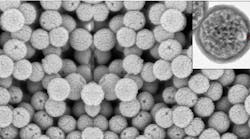Doctors may soon be using nano-scale silica bottles filled with medicine and a temperature-sensitive material to deliver drugs patients to kill malignant cells in certain parts of the patient’s body, thanks to research being done at the Georgia Institute of Technology. The research team devised a way to create silica-based hollow spheres around 200-nm in diameter, each with a small hole in the surface that would let the spheres carry a wide range of pharmaceutical payloads to be released later when the bottle is exposed to specific temperatures.
The team’s vision is that pharmacies in the future will be able to pack spheres with a mix of fatty acids, a near-infrared dye, and an anticancer drug. The fatty acids remain solid at human body temperature but melt a few degrees above. When an infrared laser is absorbed by the dye, the fatty acids quickly melt to release the drug.
“This new drug delivery method could let doctors target specific parts of the body and potentially negate some side effects because medicine is released only where there’s an elevated temperature,” says Younan Xia, professor of biomedical engineering at Georgia Tech and Emory University. “The rest of the drug remains encapsulated by the solid fatty acids inside the spheres or bottles, which are biocompatible and biodegradable.”
The researchers were also able to change the size of the holes in the spheres, which would let the so-called nanocapsules release their drugs at different rates.
An earlier method for achieving controlled drug release involved loading the temperature-sensitive material into low-density lipoproteins, which are often referred to as “bad cholesterol.” Another method required loading drugs into gold nanocages. Both have disadvantages with respect to how the material that contain the drugs interact with the body.
To make the silica-based bottles, the researchers started by making spheres out of polystyrene with a gold nanoparticle embedded in its surface. The spheres are then coated with a silica-based material everywhere except where the gold nanoparticle is embedded. Once the gold and polystyrene are removed, what remains is a hollow silica sphere with a small opening. To adjust the size of the opening, the researchers simply changed the size of the nanoparticle.
To load the nanocapsules with a mixture of fatty acids, dye, and drugs, they are first soaked in a solution containing that mixture after the trapped air is removed from the spheres. Excess materials and payload are washed away with water. The resulting nanocapsules contain a consistent mix of the temperature-sensitive material, drug, and dye.
To test the release mechanism, the researchers put some nanocapsules in water and used a near-infrared laser to heat the dye while tracking the concentration of the released therapeutic. The test confirmed that without the laser, the medicine remains encapsulated. After several minutes of heating, drug concentrations in the water increased.
“This controlled release nanocapsules let us deal with harmful effects associated with most chemotherapeutics by only releasing the drug at a dosage above the toxic level inside the diseased site,” says Jichuan Qiu, a postdoctoral researcher in team.
Josh Brown is a senior science writer at Georgia Institute of Technology.

